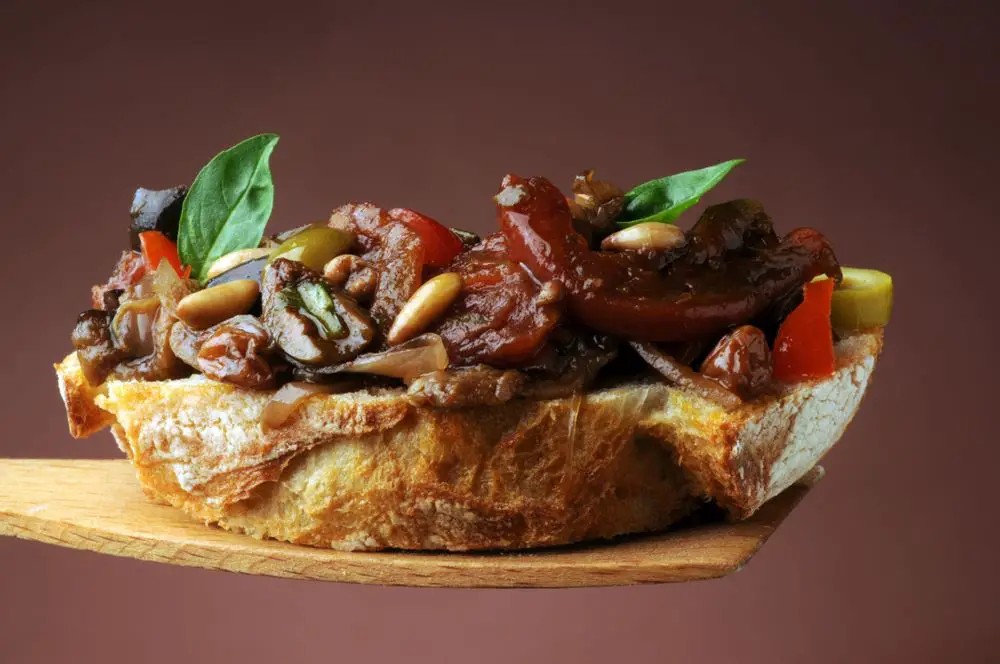The Caponata (Capunata in Sicilian) is a typical dish of Sicilian Cuisine.
It is a set of fried vegetables (mostly eggplants), seasoned with tomato sauce, celery, onion, olives and capers, in sweet and sour sauce. There are many variations, depending on the ingredients.
The Caponata, widespread throughout the Mediterranean Sea, is generally used today as a side dish or appetizer, but since the 18th century it has been a unique dish, accompanied by bread.
The etymology refers to the Spanish “caponada”, a voice with similar meaning. It should be considered a real popular etymology that traces “caponata” to “capone”, the name with which in some areas of Sicily is called the lampuga, a fish with fine but rather dry meat that was served in the tables of the aristocracy seasoned with the sweet and sour sauce typical of Caponata. The people, unable to afford the expensive fish, replaced it with the cheap eggplants. And this is the recipe that has come down to us. Some say that the name of the dish derives from the “caupone”, taverns of the sailors.
A similar Neapolitan dish is called cianfrotta. The dish is also popular in Tunisian cuisine.

Palermo‘s caponata is the simplest and most classic version. There are also variants from Agrigento, Catania, Messina and Trapani. “Arramascati” peppers, honey, garlic, chilli, basil, pine nuts or almonds and dried raisins are added to the one from Agrigento. The one from Catania includes yellow and red peppers. The Messinese recipe differs from that of Palermo due to the presence of peeled tomatoes instead of the sauce. In the Trapani version we also find peppers, vinegar and toasted almonds.
If you like Sicilian Cuisine, take a look also at these recipes: Pasta alla Norma, Pasta ‘Ncasciata, Arancini Rice Balls!
To make the caponata first clean the onions and slice it finely. Check the celery and cut into slices. Divide the green olives in half and remove the internal core.
Wash and dry the eggplants, then cut them into pieces of about 2.5 cm. Do the same with tomatoes. Heat a pan and toast the pine nuts here for a few minutes until they are golden brown. Now take back your eggplants: place the olive oil in a pan with a high rim and heat it, then add a few eggplants at a time and fry them for a few minutes. Once they are browned, drain with a slotted spoon and place them on a tray lined with absorbent paper to remove excess oil, then set aside.
Pour a generous amount of olive oil into a large saucepan, heat it and then pour the onions. Fry well until the onion is dried, then add the celery; let this brown well too and then add the capers, olives, toasted pine nuts and tomatoes.
Sauté for a few moments, then cover with the lid and cook on a low heat for 15-20 minutes. Meanwhile prepare the sweet and sour sauce: in a briquette pour the vinegar, tomato paste and sugar.
Mix well with a teaspoon and, after 15-20 minutes of cooking, add salt and pour the sauce into the pan. Stir, raise the heat and stir until the vinegar scent has evaporated. Turn off the heat, add the fried and scented eggplants with plenty of basil. Mix everything well, transfer the caponata to a serving dish and place it in the fridge because the peculiarity of the caponata is that it must be served cold or at room temperature: the next day will be even better!
The Caponata can be stored for a maximum of 2-3 days taking care to place it in the refrigerator in a glass container covered with film. Before serving, however, bring it back to room temperature, keeping it out of the fridge for a couple of hours.
In Palermo you will happen to eat the caponata together with some floured and fried octopus; another common variant consists in adding sweet pepper fillets, which you will fry together with eggplants.
This ancient dish is widespread throughout the Mediterranean and knows many variations; only in Sicily there are at least 37 versions!
Brian
We have travelled from Dublin to Napoli just for the pizza, 3 times now. What a beautiful city, I have been making pizza at home for 10 years. We also made your Pear & recotta tart, our favourite dessert.
Grazie mille.
Italian Chef
Thanks Brian! Continue to discover Italy!